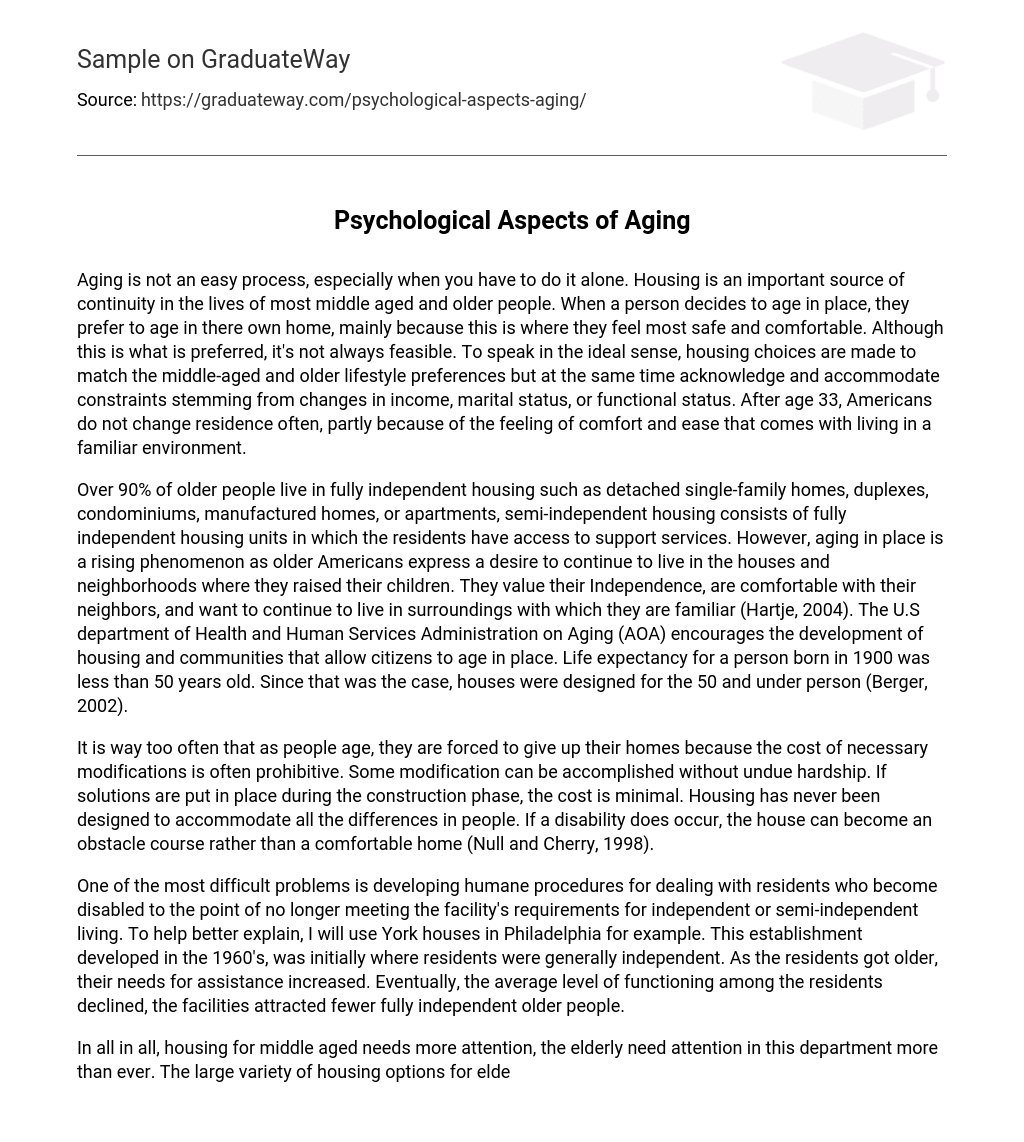Aging is not an easy process, especially when you have to do it alone. Housing is an important source of continuity in the lives of most middle aged and older people. When a person decides to age in place, they prefer to age in there own home, mainly because this is where they feel most safe and comfortable. Although this is what is preferred, it’s not always feasible. To speak in the ideal sense, housing choices are made to match the middle-aged and older lifestyle preferences but at the same time acknowledge and accommodate constraints stemming from changes in income, marital status, or functional status. After age 33, Americans do not change residence often, partly because of the feeling of comfort and ease that comes with living in a familiar environment.
Over 90% of older people live in fully independent housing such as detached single-family homes, duplexes, condominiums, manufactured homes, or apartments, semi-independent housing consists of fully independent housing units in which the residents have access to support services. However, aging in place is a rising phenomenon as older Americans express a desire to continue to live in the houses and neighborhoods where they raised their children. They value their Independence, are comfortable with their neighbors, and want to continue to live in surroundings with which they are familiar (Hartje, 2004). The U.S department of Health and Human Services Administration on Aging (AOA) encourages the development of housing and communities that allow citizens to age in place. Life expectancy for a person born in 1900 was less than 50 years old. Since that was the case, houses were designed for the 50 and under person (Berger, 2002).
It is way too often that as people age, they are forced to give up their homes because the cost of necessary modifications is often prohibitive. Some modification can be accomplished without undue hardship. If solutions are put in place during the construction phase, the cost is minimal. Housing has never been designed to accommodate all the differences in people. If a disability does occur, the house can become an obstacle course rather than a comfortable home (Null and Cherry, 1998).
One of the most difficult problems is developing humane procedures for dealing with residents who become disabled to the point of no longer meeting the facility’s requirements for independent or semi-independent living. To help better explain, I will use York houses in Philadelphia for example. This establishment developed in the 1960’s, was initially where residents were generally independent. As the residents got older, their needs for assistance increased. Eventually, the average level of functioning among the residents declined, the facilities attracted fewer fully independent older people.
In all in all, housing for middle aged needs more attention, the elderly need attention in this department more than ever. The large variety of housing options for elders includes free-standing homes, manufactured homes and etc. But despite this vast array of possibilities, most middle-and low income elders find their housing choices limited. There is a particularly strong need for emergency housing for elders who lose their housing due to fires, eviction from apartments converted to another use, or other misfortune. At least 100,00 older Americans are homeless at any given time in point.
Refrences:
1. Berger, S. (2002). Universal design raises housing living standards. Retrived January 16, 2005, from www.aarp.org/tools/Articles/a2002-07-10-computers_features_design/printable
2. Hartje, S.C (2004). Developing an incentive program for universal design in new, single-family housing. Housing and Society, 31, 195-212
3. Null, R.L.., & Cherry, K.F (1998). Universal design: Creative solutions for ADA compliance. Belmont CA: Professional Publications.
Summaries:
1. (Null & Cherry, 1998): The main point that is being made here is that way too often that the elderly are forced to give up their homes because the cost of necessary modifications is often prohibitive. Surprisingly, 30% of people living in the U.S would rather die than to move into a nursing home. That is strong sentiment for wanting to stay in a familiarly home as a person ages. Housing has never been designed to accommodate all the differences in people.
2. Hartje, S.C (2004): The main point here that Harje is trying to highlight is the foundation of the homes being built for the elders. Built environment professionals need to design houses that will allow aging in place or develop solutions that can be applied to existing houses to make them user friendly as the homeowners age.
3. Berger, S. (2002): Berger discusses the accommodations made to suite the elderly once moving from their homes. Their needs to be a universal design when building homes. Universal design simply means that the houses where individuals and families live and the products they use are designed to accommodate people of all physical abilities, not just elderly or disable persons. Incorporating these design features into the everyday living environment would make living easier for all persons in the house, both present and future.
Questions:
1. What modifications are going to be made to suite the elderly once they decide to move from their homes and in to assisted living facilities.
2. Being that the elderly prefer to age in their homes and their homes are not suitable for living, why can’t their be contractors to come in and do the necessary work?





